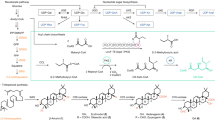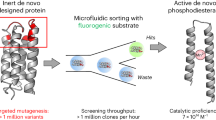Abstract
This protocol describes the purification of a recombinant high molecular weight (HMW) two-partner secretion exoprotein (generically referred to as TpsA proteins) from Escherichia coli using methods developed recently to obtain highly purified flagellin-free recombinant EtpA (rEtpA) glycoprotein. The protocol addresses problems frequently encountered with the expression of these HMW proteins, namely plasmid instability and protein degradation, as well as a recently recognized issue of flagellin contamination. Briefly, the TpsA protein of interest is expressed with its outer membrane transporter (TpsB) protein in a flagellin-minus recombinant E. coli background. Culture supernatants are collected, concentrated through high molecular weight cutoff filters, followed by purification by size exclusion column chromatography. Details are included for the expression of HMW TpsA glycoproteins as polyhistidine-tagged molecules, which can be further purified by metal affinity chromatography (MAC). Using this protocol, it is possible to obtain highly purified microgram–milligram quantities of the TpsA protein of interest within 2–3 days.
This is a preview of subscription content, access via your institution
Access options
Subscribe to this journal
Receive 12 print issues and online access
$259.00 per year
only $21.58 per issue
Buy this article
- Purchase on Springer Link
- Instant access to full article PDF
Prices may be subject to local taxes which are calculated during checkout






Similar content being viewed by others
References
Jacob-Dubuisson, F., Locht, C. & Antoine, R. Two-partner secretion in Gram-negative bacteria: a thrifty, specific pathway for large virulence proteins. Mol. Microbiol. 40, 306–313 (2001).
Ward, J.I. et al. Efficacy of an acellular pertussis vaccine among adolescents and adults. N. Engl. J. Med. 353, 1555–1563 (2005).
Greco, D. et al. A controlled trial of two acellular vaccines and one whole-cell vaccine against pertussis. Progetto Pertosse Working Group. N. Engl. J. Med. 334, 341–348 (1996).
Roy, K. et al. Enterotoxigenic Escherichia coli EtpA mediates adhesion between flagella and host cells. Nature 457, 594–598 (2009).
Roy, K., Hamilton, D., Allen, K.P., Randolph, M.P. & Fleckenstein, J.M. The EtpA exoprotein of enterotoxigenic Escherichia coli promotes intestinal colonization and is a protective antigen in an experimental model of murine infection. Infect. Immun. 76, 2106–2112 (2008).
St Geme III, J.W. & Grass, S. Secretion of the Haemophilus influenzae HMW1 and HMW2 adhesins involves a periplasmic intermediate and requires the HMWB and HMWC proteins. Mol. Microbiol. 27, 617–630 (1998).
Fleckenstein, J.M., Roy, K., Fischer, J.F. & Burkitt, M. Identification of a two-partner secretion locus of enterotoxigenic Escherichia coli. Infect. Immun. 74, 2245–2258 (2006).
Buscher, A.Z., Grass, S., Heuser, J., Roth, R. & St Geme, J.W. Surface anchoring of a bacterial adhesin secreted by the two-partner secretion pathway. Mol. Microbiol. 61, 470–483 (2006).
Mazar, J. & Cotter, P.A. New insight into the molecular mechanisms of two-partner secretion. Trends Microbiol. 15, 508–515 (2007).
Grass, S. et al. The Haemophilus influenzae HMW1 adhesin is glycosylated in a process that requires HMW1C and phosphoglucomutase, an enzyme involved in lipooligosaccharide biosynthesis. Mol. Microbiol. 48, 737–751 (2003).
Szymanski, C.M. & Wren, B.W. Protein glycosylation in bacterial mucosal pathogens. Nat. Rev. Microbiol. 3, 225–237 (2005).
Clantin, B. et al. The crystal structure of filamentous hemagglutinin secretion domain and its implications for the two-partner secretion pathway. Proc. Natl. Acad. Sci. USA 101, 6194–6199 (2004).
Bailey, L., Agger, S., Peterson, L., Thompson, J. & Weaver, T. Crystallization of truncated hemolysin A from Proteus mirabilis. Acta Crystallographica Section F 61, 448–450 (2005).
Bradley, P., Cowen, L., Menke, M., King, J. & Berger, B. BETAWRAP: successful prediction of parallel beta-helices from primary sequence reveals an association with many microbial pathogens. Proc. Natl. Acad. Sci. USA 98, 14819–14824 (2001).
Hodak, H. & Jacob-Dubuisson, F. Current challenges in autotransport and two-partner protein secretion pathways. Res. Microbiol. 158, 631–637 (2007).
Renn, J.P. & Clark, P.L. A conserved stable core structure in the passenger domain beta-helix of autotransporter virulence proteins. Biopolymers 89, 420–427 (2008).
Menozzi, F.D., Gantiez, C. & Locht, C. Interaction of the Bordetella pertussis filamentous hemagglutinin with heparin. FEMS Microbiol. Lett. 62, 59–64 (1991).
Hertle, R., Sussmuth, R., Braun, V. & Jung, G. Two-step fast protein liquid chromatographic purification of the Serratia marcescens hemolysin and peptide mapping with mass spectrometry. J. Chromatogr. B Biomed. Sci. Appl. 737, 13–23 (2000).
Grass, S. & St Geme III, J.W. Maturation and secretion of the non-typable Haemophilus influenzae HMW1 adhesin: roles of the N-terminal and C-terminal domains. Mol. Microbiol. 36, 55–67 (2000).
Golemis, E. & Adams, P.D. Protein-Protein Interactions: A Molecular Cloning Manual 2nd edn. (Cold Spring Harbor Laboratory Press, New York, USA, 2005).
Nelson, K.M., Young, G.M. & Miller, V.L. Identification of a locus involved in systemic dissemination of Yersinia enterocolitica. Infect. Immun. 69, 6201–6208 (2001).
Barenkamp, S.J. & St Geme III, J.W. Genes encoding high-molecular-weight adhesion proteins of nontypeable Haemophilus influenzae are part of gene clusters. Infect. Immun. 62, 3320–3328 (1994).
Snyder, L. & Champness, W. in Molecular Genetics of Bacteria (ed. Snyder, L.) Vol. 1 Ch. 4 176–177 (ASM Press, Washington DC, USA, 2003).
Kholod, N. & Mustelin, T. Novel vectors for co-expression of two proteins in E. coli. BioTechniques 31, 322–323 326–328 (2001).
Guzman, L.M., Belin, D., Carson, M.J. & Beckwith, J. Tight regulation, modulation, and high-level expression by vectors containing the arabinose PBAD promoter. J. Bacteriol. 177, 4121–4130 (1995).
Hayashi, F. et al. The innate immune response to bacterial flagellin is mediated by Toll-like receptor 5. Nature 410, 1099–1103 (2001).
Westermeier, R. Sensitive, quantitative, and fast modifications for Coomassie blue staining of polyacrylamide gels. Proteomics 6 (Suppl 2): 61–64 (2006).
Chang, A.C. & Cohen, S.N. Construction and characterization of amplifiable multicopy DNA cloning vehicles derived from the P15A cryptic miniplasmid. J. Bacteriol. 134, 1141–1156 (1978).
Laemmli, U.K. Cleavage of structural proteins during the assembly of the head of bacteriophage T4. Nature 227, 680–685 (1970).
Towbin, H., Staehelin, T. & Gordon, J. Electrophoretic transfer of proteins from polyacrylamide gels to nitrocellulose sheets: procedure and some applications. Proc. Natl. Acad. Sci. USA 76, 4350–4354 (1979).
Acknowledgements
This work was supported by grants from the National Institutes of Health (National Center for Research Resources) RR16190-05, the Department of Veterans Affairs and funds from the University of Tennessee Microbial Pathogenesis Research Center.
Author information
Authors and Affiliations
Corresponding author
Ethics declarations
Competing interests
The University of Tennessee Research corporation has filled for a patent on the use of EtpA and flagellin in the treatment/prevention of Gram-negative infections.
Rights and permissions
About this article
Cite this article
Fleckenstein, J., Roy, K. Purification of recombinant high molecular weight two-partner secretion proteins from Escherichia coli. Nat Protoc 4, 1083–1092 (2009). https://doi.org/10.1038/nprot.2009.87
Published:
Issue Date:
DOI: https://doi.org/10.1038/nprot.2009.87
This article is cited by
Comments
By submitting a comment you agree to abide by our Terms and Community Guidelines. If you find something abusive or that does not comply with our terms or guidelines please flag it as inappropriate.



